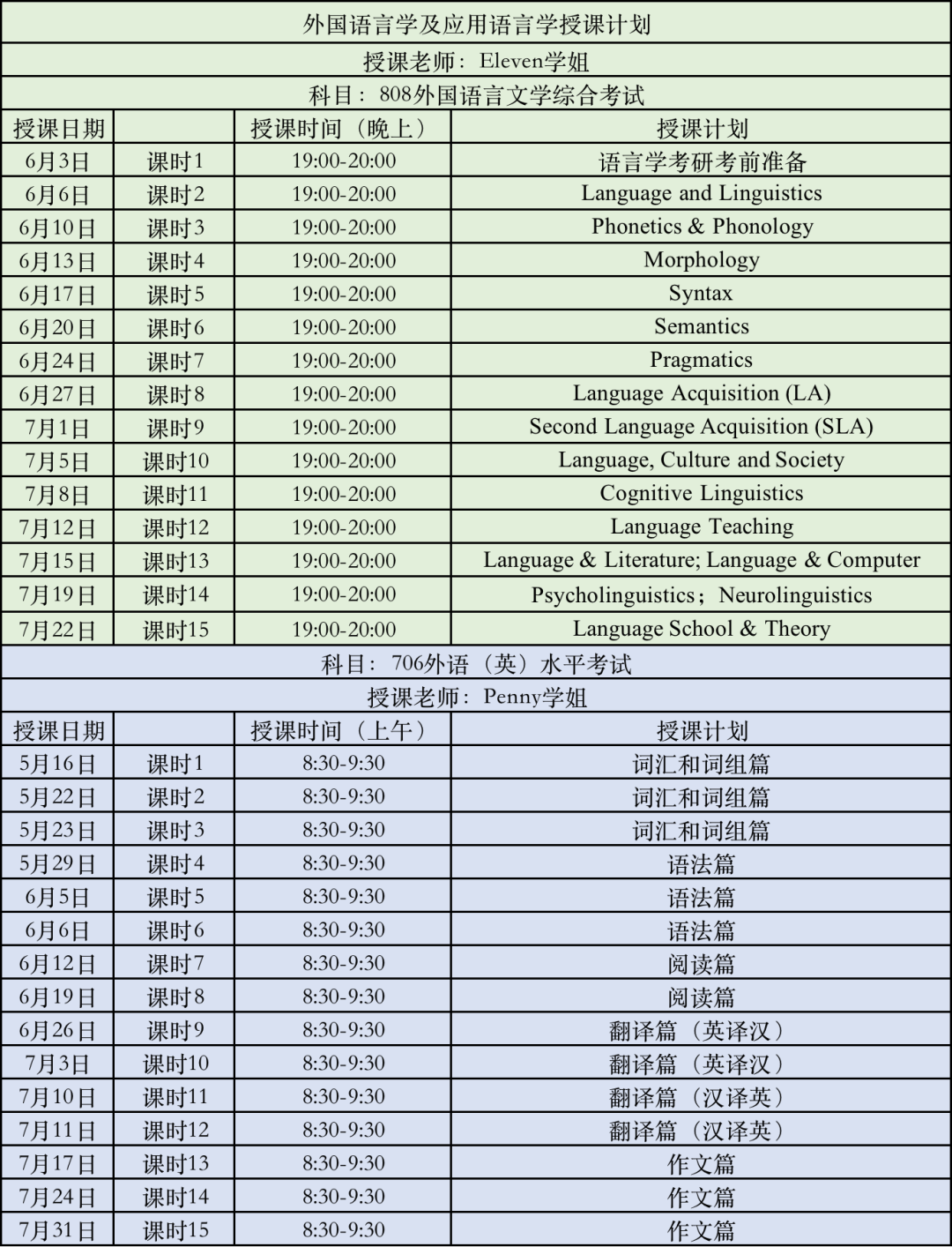
授课教师 专业课 808:外国语言文学综合考试 Eleven学姐:2020届暨大外国语言学及应用语言学专业在读,考研专业课二(808)131分,排名第一。本科期间通过专四(良好),专八(成绩未出),高中英语教师资格证。
专业课 706:外语(英)水平考试 Penny学姐:2020届暨大英语语言文学专业在读,初试排名并列第一,总排名第一。初试总分400分,专业课一(706)106分,专业课二(808)139分。本科期间通过专四(专八成绩未出),CATTI三级笔译,四六级580+。 教学特点与经验:有相关教学经验,备课充分,认真上课,课后监督,及时反馈。善于抓住考试重点,突破难点,精讲精练,善于总结。 辅导科目 706 外语水平考试808外国语言文学综合考试
授课课时 706:15课时(60分钟/课时)808:15课时(60分钟/课时)
授课时间

授课教材 706 外语水平考试 1.暨大往年真题资料 2.英语专业八级考试精品范文100篇
808外国语言文学综合考试 1.戴炜栋、何兆熊主编,《新编简明英语语言学教程》,上海外语教育出版社,2010年。(第二版)
2.胡壮麟主编,《语言学教程》,北京大学出版社,2006年。(第三版)(第四、五版均可) 课程优势 706 外语水平考试 掌握各个题型答题技巧,夯实基本的英语知识能力。重点为复习方法和解题思路,题型预测考法,让大家的复习更有针对性。售课期间也会有相对应的习题进行练习,有的放矢。
808外国语言文学综合考试 1、本课程将对两本语言学参考书目的知识点进行整合,梳理出知识重难点,整理思维导图,有助于考生全面了解和记忆语言学各分支的理论,以及对语言学考研在本章节的考查范围和方向有较清晰的认识,系统化备考。 2、在授课过程中,根据真题的题型和考察范围,搭配实例有所侧重地讲解语言学各章节内容,配合对应练习题,有助于考生理解语言学中抽象的概念,真正掌握语言学知识内涵,高效率备战语言学考研。 授课计划 706 外语水平考试 课时1-3:词汇和词组篇 根据真题列出暨大考察词汇和词组难度,挑选出重点的词汇和词组进行讲解以及相关练习。
课时4-6:语法篇 根据真题列出暨大高频语法点和重难点语法点,逐一进行讲解以及相关练习。
课时7-8:阅读篇 根据真题列出往年阅读出题的题源,讲解阅读答题技巧。
课时9-10:翻译篇(英译汉) 根据往年真题讲解英译汉需要掌握的词组词汇以及英译汉答题技巧以及相关练习讲解。
课时11-12:翻译篇(汉译英) 根据往年真题讲解汉译英需要掌握的词组词汇以及汉译英答题技巧以及相关练习讲解。
课时13-15:作文篇 对往年真题作文题型进行分类,讲解写作基本框架。
808外国语言文学综合考试 课时1:语言学考研考前准备 1.如何做好考研前期准备? 2.如何做好本课程课前准备? 3.语言学考研真题怎么考? 4.如何高效备战语言学考研?
课时2:Language and Linguistics 1.对语言和语言学主要知识点进行讲解; 2.结合真题解析本章知识点考察方式; 3.绘制本章节知识重难点思维导图; 4.主要内容:definition of language, functions of language, design features, definition of linguistics, prescriptive vs. descriptive, synchronic vs. diachronic, speech vs. writing, langue vs. Parole, competence vs. performance, traditional grammar vs. Modern linguistics, etc. 课时3:Phonetics & Phonology 1.对语音学和音系学主要知识点进行讲解; 2.结合真题解析本章知识点考察方式; 3.绘制本章节知识重难点思维导图; 4.主要内容:definition of phonetics & phonology, difference between phonetics and phonology, IPA, manner of articulation & place of articulation, cardinal vowel, coarticulation; phone, phoneme & allophone, phonological theory, phonological rules, suprasegmental features (syllable structure, stress, tone & intonation), etc. 课时4:Morphology 1.对形态学主要知识点进行讲解; 2.结合真题解析本章节知识点考察方式; 3.绘制本章节知识重难点思维导图; 4.主要内容:definition of morphology, identification of words, classification of words, lexical changes, inflection & derivation, morpheme, types of morpheme (free morpheme & bound morpheme, root, affix, stem), etc.
课时5:Syntax 1.对句法学主要知识点进行讲解; 2.结合真题解析本章节知识点考察方式; 3.绘制本章节知识重难点思维导图; 4.主要内容:definition of syntax, syntactic relations, category, IC analysis, syntagmatic relation & paradigmatic relation, endocentric construction & exocentric construction etc. 课时6:Semantics 1.对语义学主要知识点进行讲解; 2.结合真题解析本章节知识点考察方式; 3.绘制本章节知识重难点思维导图; 4.主要内容:definition of semantics, 7 types of meaning by Leech, naming theory, semantic triangle, contextualism, behaviorism, sense vs. reference, sense relations, sentence relations, componential analysis, predication analysis, grammaticality, selectional restriction, integrated theory, etc.
课时7:Pragmatics 1.对语用学主要知识点进行讲解; 2.结合真题解析本章节知识点考察方式; 3.绘制本章节知识重难点思维导图; 4.本课内容包括:definition of pragmatics, difference between semantics & pragmatics, context, sentence meaning vs. utterance meaning, constative vs. performative, speech act theory, Searle’s classification of speech acts, cooperative principle, politeness principle, relevance theory, etc.
课时8:Language Acquisition (LA) 1.对语言习得主要知识点进行讲解; 2.结合真题解析本章节知识点考察方式; 3.绘制本章节知识重难点思维导图; 4.主要内容:definition of language acquisition(LA), behaviorist view of LA, innatist view of LA, interactionist view of LA, stages of LA, critical period hypothesis, atypical development, etc.
课时9:Second Language Acquisition (SLA) 1.对二语习得主要知识点进行讲解; 2.结合真题解析本章节知识点考察方式; 3.绘制本章节知识重难点思维导图; 4.主要内容:definition of SLA, foreign language vs. second language, language transfer, contrastive analysis (CA), error analysis (EA), mistake vs. error, interlingual errors vs. intralingual errors, interlanguage, input hypothesis, individual differences, etc.
课时10:Language, Culture and Society 1.对语言与文化、语言与社会主要知识点进行讲解; 2.结合真题解析本章节知识点考察方式; 3.绘制本章节知识重难点思维导图; 4.主要内容:relationship between language & culture,discourse community vs. discourse accent, Sapir-Whorf hypothesis, acculturation, assimilation, amalgamation, culture overlap, cultural diffusion, culture imperialism vs. linguistic nationalism, intercultural communication; sociolinguistics, speech community, varieties of language, register, pidgin vs. creole, bilingualism vs. diglossia, etc.
课时11:Cognitive Linguistics 1.对认知语言学主要知识点进行讲解; 2.结合真题解析本章节知识点考察方式; 3.绘制本章节知识重难点思维导图; 4.主要内容:definition of cognitive linguistics, construal & construal operation, categorization, image schema, metaphor, metonymy, blending theory, etc.
课时12:Language Teaching 1.对语言教学主要知识点进行讲解; 2.结合真题解析本章节知识点考察方式; 3.绘制本章节知识重难点思维导图; 4.主要内容:definition of applied linguistics, relationship between linguistics & language teaching, grammar & language teaching, discourse-based view of language teaching, communicative competence, universal grammar(UG) & language teaching, syllabus vs. curriculum, types of syllabus, etc.
课时13:Language & Literature; Language & Computer 1.对语言与文学、计算机语言学主要知识点进行讲解; 2.结合真题解析本章节知识点考察方式; 3.绘制本章节知识重难点思维导图; 4.主要内容:stylistics, foregrounding & grammatical form, literal language vs. Figurative language, simile, metaphor, metonymy, synecdoche, pointe of view, computational linguistics, computer-assisted language learning (CALL), corpus linguistics, concordance,etc.
课时14:Psycholinguistics;Neurolinguistics 1.对心理语言学、神经语言学主要知识点进行讲解; 2.结合真题解析本章节知识点考察方式; 3.绘制本章节知识重难点思维导图; 4.主要内容:definition of psycholinguistics, definition of neurolinguistics, methods of neurolinguistics, aphasia, language comprehension, cohort model, interactive model, race model, language production, serial model, parallel model, Minimal attachment, garden path sentence, etc.
课时15:Language School & Theory 1.对语言学各流派以及理论主要知识点进行讲解; 2.结合真题解析本章节知识点考察方式; 3.绘制本章节知识重难点思维导图; 4.主要内容:the Prague school,functional sentence perspective, communicative dynamism, the London school (Malinowski, Firth & Halliday), American structuralism (Bloomfield & post-Bloomfield period), transformational-generative grammar (TG grammar), etc.
|  /2
/2 